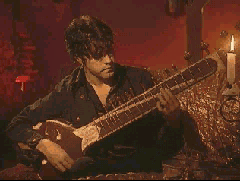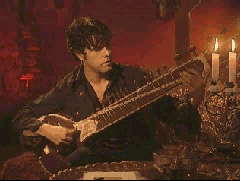Sitar
Introduction
A sitar is basically a hollowed out pumpkin with a neck, a gourd at the top of the neck
which is for extra resonatoin, and 19 strings. The Sitar is an ancient Indian instrument; the
design is over 600 years old.
The Sitar has another relative called a Tambura. It's basically a fretless drone Sitar;
almost the bass Sitar.
Information on the Sitar
The Sitar is an ancient Indian instrument adapted from another ancient Indian instrument,
The Southern Veena. It is constructed using a design over 600 years old. It is made of a
dried out pumpkin for the body, Tun or Sheasham wood for the neck, and a dried out
gourd for the resonator at the top of the neck. The Sitar has 7 strings on the upper part of
the body and 11 or 12 sympathetic strings under the frets. To allow the sympathetic
strings to be under the frets and resonate, the curved nickel-silver frets are arch-shaped
to allow for free resonation. All frets on a Sitar are moveable. They are held to the neck
only with strings.There are a few variations on the design such as the single Sitar which
does not have the sympathetic strings and the double Sitar, which does not have the
gourd at the top of the neck.
It is made of a
dried out pumpkin for the body, Tun or Sheasham wood for the neck, and a dried out
gourd for the resonator at the top of the neck. The Sitar has 7 strings on the upper part of
the body and 11 or 12 sympathetic strings under the frets. To allow the sympathetic
strings to be under the frets and resonate, the curved nickel-silver frets are arch-shaped
to allow for free resonation. All frets on a Sitar are moveable. They are held to the neck
only with strings.There are a few variations on the design such as the single Sitar which
does not have the sympathetic strings and the double Sitar, which does not have the
gourd at the top of the neck.
To play the Sitar is similar to playing the guitar although there are a few variations in the
styles of playing. First, instead of using a pick, a Sitarist uses 2 mizrabs, which is a metal
finger pick. One mizrab is placed on the index finger and the other on the pinky. Second,
the sitting position of the Sitar is quite different from a guitar. Thirdly, the tuning of the
Sitar is quite different. The fourth and most dramatic difference in playing is the Indian
Music System which is very, very complicated and will just confuse the hell out of
anybody who tries to make sense of it.
First, instead of using a pick, a Sitarist uses 2 mizrabs, which is a metal
finger pick. One mizrab is placed on the index finger and the other on the pinky. Second,
the sitting position of the Sitar is quite different from a guitar. Thirdly, the tuning of the
Sitar is quite different. The fourth and most dramatic difference in playing is the Indian
Music System which is very, very complicated and will just confuse the hell out of
anybody who tries to make sense of it.
More
Sitar Information
The sitar is a classical instrument of Northern India which has 19 strings, 20 frets and an
amazing sound. Traditionally the instrument is taught using the old indian gurukul
system, when a student lives with his teacher or guru for the duration of their training.
There is a proverb that says a student of the sitar must spend 20 years learning, twenty
years performing, and twenty years teaching the instrument to truly appreciate it. Modern
technology, and a fascination with the instrument, spawning from the '60s and Ravi
Shankar has created a breed of "self-teaching" sitarists who purchase books and videos
about the instrument.
One of the most versatile instruments in the world, the sitar allows a musician a wide
range of expression. Micro-tonal variation is very easy to create The frets  (the numerous
bar like objects that cross the fingerboard (main part) of the sitar) are posable and are tied
onto the instrument. Different ragas emphasize different positions, and the artist often
sets the frets a little off normal to provide the micro-tonal combination that he
desires.
(the numerous
bar like objects that cross the fingerboard (main part) of the sitar) are posable and are tied
onto the instrument. Different ragas emphasize different positions, and the artist often
sets the frets a little off normal to provide the micro-tonal combination that he
desires.
Unlike guitar frets, sitar frets are very curved and raised above the fingerboard and some
strings actually run under them, and thus can not be fretted. When a string is fretted the
tone or note it produces will change. The curved frets allow more versatility in bending a
note than on a guitar. Bending a note involves pulling or pushing the sting it is made with
into a different position on the fret, thus tightening the string and raising the pitch. The
more you bend, the higher the note is. The sitar is played with a wire metal pick called a
mizrab which allows the musician to play every level of strings at the same time.


Back
 It is made of a
dried out pumpkin for the body, Tun or Sheasham wood for the neck, and a dried out
gourd for the resonator at the top of the neck. The Sitar has 7 strings on the upper part of
the body and 11 or 12 sympathetic strings under the frets. To allow the sympathetic
strings to be under the frets and resonate, the curved nickel-silver frets are arch-shaped
to allow for free resonation. All frets on a Sitar are moveable. They are held to the neck
only with strings.There are a few variations on the design such as the single Sitar which
does not have the sympathetic strings and the double Sitar, which does not have the
gourd at the top of the neck.
It is made of a
dried out pumpkin for the body, Tun or Sheasham wood for the neck, and a dried out
gourd for the resonator at the top of the neck. The Sitar has 7 strings on the upper part of
the body and 11 or 12 sympathetic strings under the frets. To allow the sympathetic
strings to be under the frets and resonate, the curved nickel-silver frets are arch-shaped
to allow for free resonation. All frets on a Sitar are moveable. They are held to the neck
only with strings.There are a few variations on the design such as the single Sitar which
does not have the sympathetic strings and the double Sitar, which does not have the
gourd at the top of the neck.  First, instead of using a pick, a Sitarist uses 2 mizrabs, which is a metal
finger pick. One mizrab is placed on the index finger and the other on the pinky. Second,
the sitting position of the Sitar is quite different from a guitar. Thirdly, the tuning of the
Sitar is quite different. The fourth and most dramatic difference in playing is the Indian
Music System which is very, very complicated and will just confuse the hell out of
anybody who tries to make sense of it.
First, instead of using a pick, a Sitarist uses 2 mizrabs, which is a metal
finger pick. One mizrab is placed on the index finger and the other on the pinky. Second,
the sitting position of the Sitar is quite different from a guitar. Thirdly, the tuning of the
Sitar is quite different. The fourth and most dramatic difference in playing is the Indian
Music System which is very, very complicated and will just confuse the hell out of
anybody who tries to make sense of it. (the numerous
bar like objects that cross the fingerboard (main part) of the sitar) are posable and are tied
onto the instrument. Different ragas emphasize different positions, and the artist often
sets the frets a little off normal to provide the micro-tonal combination that he
desires.
(the numerous
bar like objects that cross the fingerboard (main part) of the sitar) are posable and are tied
onto the instrument. Different ragas emphasize different positions, and the artist often
sets the frets a little off normal to provide the micro-tonal combination that he
desires.
